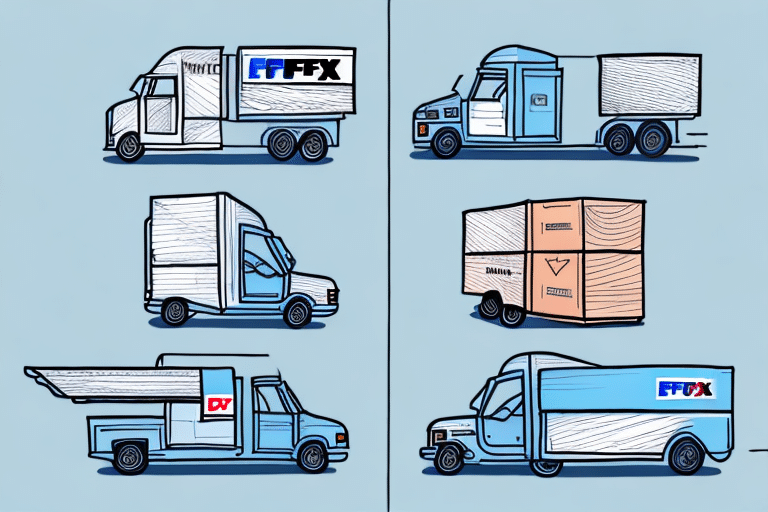Comparing Prices: Which Is Cheaper, FedEx or UPS?
When it comes to shipping packages, the post office is no longer the only option. With a plethora of private shipping companies available, FedEx and UPS stand out as popular choices. But which one is cheaper? Understanding the pricing structure of each carrier, as well as the various factors that can impact shipping costs, is crucial in making an informed decision. In this article, we will examine the costs associated with shipping packages with FedEx and UPS, as well as other considerations to help you determine which carrier is the best choice for your mailing needs.
Introduction: The Importance of Comparing Shipping Prices
For individuals and businesses that frequently ship packages, understanding how to compare shipping prices is essential. Shipping costs can significantly impact a business's bottom line or an individual's budget, making it crucial to choose the most cost-effective carrier. According to the 2023 Shipping Industry Report by Statista, optimizing shipping strategies can lead to substantial savings annually.
While both FedEx and UPS are well-respected and reliable shipping options, differences in their pricing structures and fees can make one a better choice for your specific needs than the other. By comparing the costs and features of each carrier, you can make an informed decision that can save you both time and money in the long run.
Key factors to consider when comparing shipping prices include:
- Package Type: Different carriers may offer better rates for certain types of packages, such as those that are heavier or larger in size.
- Destination: The cost of shipping can vary based on whether the destination is domestic or international, as well as specific regions or countries.
- Service Level: Faster delivery times or additional services like package tracking or insurance can impact the overall cost.
The Factors That Affect Shipping Costs: Weight, Distance, and Speed
Several factors can impact the cost of shipping a package, with weight and distance being the most significant. According to FedEx's shipping guidelines, the cost increases progressively with the weight and size of the package. Similarly, UPS's shipping calculator shows that shipping rates scale with both weight and distance.
Key Factors Influencing Shipping Costs:
- Weight: Heavier packages incur higher shipping fees. For instance, shipping a 5-pound package via FedEx Express Saver might cost around $15, whereas a 20-pound package could cost upwards of $40.
- Distance: The farther the package travels, the higher the cost. Shipping domestically within the United States generally costs less than international shipping. For example, shipping a package from New York to California via FedEx Ground might cost approximately $10, while the same package internationally could cost upwards of $50.
- Speed: Expedited shipping options, such as overnight or two-day delivery, typically cost more than standard ground shipping. Overnight shipping with UPS Next Day Air can cost around $30 for a small package, compared to standard UPS Ground shipping at approximately $10.
- Package Size and Dimensions: Oversized or irregularly shaped packages may incur additional fees due to special handling requirements.
- Additional Services: Options like insurance, tracking, and signature confirmation add to the overall cost but provide extra security and peace of mind.
The Basic Pricing Structure of FedEx and UPS
Both FedEx and UPS use a similar pricing structure based on the package's weight, destination, and desired delivery speed. However, the exact rates and fees charged by each carrier can vary widely. Both FedEx and UPS offer a range of shipping options beyond the basic structure, including expedited shipping, international shipping, and specialized services.
For high-volume shippers, both carriers provide discounts and special pricing tiers. Businesses regularly shipping large volumes may benefit from significant cost savings through negotiated rates or volume-based discounts.
Additionally, both FedEx and UPS offer online tools to help calculate shipping costs and compare rates between the two companies. Utilizing these tools by inputting specific shipment details can ensure you're getting the most accurate and competitive pricing for your shipping needs.
Factors Determining the Cost of Shipping with FedEx
FedEx's shipping rates are primarily based on the weight and dimensions of the package, the distance it will travel, and the speed at which it will arrive. FedEx offers several shipping options, including Ground, Express, and International delivery. However, additional fees for fuel surcharges, residential delivery, and insurance are set by the carrier.
The weight and dimensions of the package are the most significant factors in determining the cost of shipping with FedEx. The heavier and larger the package, the more expensive it will be to ship. For example, a standard FedEx Ground package within the U.S. may start at around $8 for a small, lightweight package, increasing as weight and size increase.
Shipping to remote or rural areas may cost more than shipping to major cities due to additional handling and longer transit times. International shipping rates are typically higher than domestic rates due to customs fees, taxes, and varying international regulations.
Additional services such as insurance, signature confirmation, and special handling can also increase the overall cost of shipping with FedEx. It’s essential to consider these additional costs when budgeting for shipping expenses.
Factors Determining the Cost of Shipping with UPS
UPS determines its shipping costs based on package weight, size, and destination. The sender can choose from different shipping options such as Ground, Air (including Next Day Air and 2nd Day Air), and International shipping. Additional fees for special services such as delivery confirmation or signature confirmation may apply and are set by the carrier.
Similar to FedEx, the weight and dimensions of the package significantly impact the cost of shipping with UPS. For example, UPS Ground rates may start at around $7 for small, lightweight packages and increase with larger, heavier shipments.
UPS also offers discounts for high-volume shippers and those who utilize their online shipping tools. This can lead to substantial savings for businesses that ship frequently. Additionally, UPS may charge extra fees for packages that require special handling due to their fragility or hazardous nature.
Destination plays a crucial role in determining shipping costs with UPS. Shipping to international destinations involves higher costs due to customs duties, taxes, and regulatory requirements. Residential deliveries may also incur additional surcharges compared to commercial addresses.
Analyzing the Differences in Shipping Rates between FedEx and UPS
While the basic pricing structure of both FedEx and UPS is similar, there are notable differences to consider when comparing shipping rates. Generally, FedEx is often less expensive for short distances and lighter packages, making it a favorable option for domestic shipping within close proximity. Conversely, UPS tends to be more cost-effective for heavier packages and longer distances, especially for businesses that ship in bulk.
Service offerings also differ between the two carriers. For example, FedEx may offer more competitive rates for international shipping, particularly to Europe and Asia, while UPS may provide better rates for expedited shipping services within the United States.
Additionally, the pricing for specific services such as same-day delivery, freight shipping, and specialized handling can vary between FedEx and UPS. It's essential to compare rates for the specific services you require to determine which carrier offers the best value for your needs.
In some cases, the price differences between the two carriers can be negligible, especially when considering additional factors such as delivery reliability, tracking capabilities, and customer service quality.
How to Determine Which Carrier is Cheaper for Your Specific Needs
The most effective way to determine which carrier is cheaper for your specific needs is to use their respective online calculators. Both FedEx and UPS provide tools that allow you to input the package's weight, dimensions, destination, and desired delivery speed to receive an accurate price quote.
Here’s a step-by-step approach to comparing costs:
- Gather Package Details: Note the weight, dimensions, and value of your package.
- Select Shipping Options: Choose the desired shipping speed (e.g., standard, expedited, overnight).
- Enter Destination Information: Provide the pickup and delivery addresses.
- Compare Quotes: Use the online calculators to obtain quotes from both FedEx and UPS.
- Consider Additional Services: Factor in costs for insurance, tracking, and any other necessary services.
Comparing the prices for your specific shipment can help determine which carrier will be the most cost-effective for you. Additionally, consider the overall value, including delivery reliability and customer service, when making your decision.
An Overview of FedEx's Delivery Services: Ground, Express, and International Shipping Options
FedEx offers a variety of delivery services tailored to different shipping needs:
- FedEx Ground: The most affordable option for domestic shipping within the U.S., offering reliable delivery within 1-5 business days.
- FedEx Express: Provides faster delivery options, including Overnight, 2-Day, and 3-Day services, suitable for urgent shipments.
- FedEx International: Enables shipping to over 220 countries and territories worldwide, with options like International Priority and International Economy.
- FedEx Freight: Designed for larger, heavier shipments, offering both LTL (Less Than Truckload) and truckload services.
Each service level comes with its own pricing structure, allowing customers to choose based on their budget and delivery speed requirements. For detailed information on FedEx's services and pricing, visit the FedEx Shipping Services page.
The Types of Delivery Services Offered by UPS: Ground, Air, and International Shipping Options
UPS provides a comprehensive range of delivery services to meet various shipping needs:
- UPS Ground: An economical option for domestic shipments within the U.S., ensuring delivery within 1-5 business days.
- UPS Air: Includes services like Next Day Air, 2nd Day Air, and 3 Day Select, catering to time-sensitive shipments.
- UPS International: Facilitates shipping to over 220 countries and territories, with options such as UPS Worldwide Express and UPS Worldwide Saver.
- UPS Freight: Suitable for shipping large or heavy items, offering services like UPS Freight LTL and UPS Freight Truckload.
UPS also offers specialized services, including UPS My Choice for delivery management and UPS SurePost for residential deliveries. For more details on UPS's delivery services and pricing, visit the UPS Shipping Services page.
Additional Fees to Consider When Choosing Between FedEx and UPS
Beyond the basic shipping rates, both FedEx and UPS impose additional fees that can affect the total cost of your shipment. Understanding these fees is essential for accurate cost comparison:
- Fuel Surcharges: Both carriers add fuel surcharges based on fluctuating fuel prices. These surcharges are typically a percentage of the base shipping rate.
- Residential Delivery Surcharges: Delivering to residential addresses often incurs additional fees compared to commercial locations.
- Insurance: Protecting valuable or fragile items with shipping insurance adds to the overall cost.
- Signature Confirmation: Requiring a signature upon delivery ensures package security but may involve extra fees.
- Special Handling Fees: Packages that are oversized, heavy, or require special handling may incur additional charges.
It's crucial to account for these additional fees when calculating the total cost of shipping with FedEx or UPS. Reviewing each carrier's fee schedule on their official websites can provide clarity and help prevent unexpected expenses.
Tips for Saving Money on Your Shipping Costs with FedEx or UPS
Shipping costs can add up, especially for businesses that ship regularly. Here are some effective strategies to reduce your shipping expenses with FedEx or UPS:
1. Optimize Package Size and Weight
Reducing the size and weight of your packages can significantly lower shipping costs. Use appropriately sized packaging and avoid excess weight by selecting the right materials.
2. Consolidate Shipments
Combining multiple packages into a single shipment can help you take advantage of bulk shipping rates and reduce overall costs.
3. Utilize Online Shipping Tools
Both FedEx and UPS offer online tools that provide discounts for printing shipping labels and managing shipments digitally. Utilizing these tools can lead to savings and streamline your shipping process.
4. Negotiate Rates
If you are a high-volume shipper, consider negotiating rates directly with FedEx or UPS. Many carriers offer customized pricing for businesses that ship large quantities regularly.
5. Choose the Right Service Level
Selecting the appropriate service level based on your delivery needs can prevent overpaying for expedited services you don't require. Assess the urgency of each shipment to choose the most cost-effective option.
6. Take Advantage of Business Accounts
Setting up a business account with FedEx or UPS can provide access to exclusive discounts, better rates, and enhanced service options tailored to your business needs.
Comparing Customer Service Quality between FedEx and UPS
Customer service is a critical factor when choosing between FedEx and UPS. Both carriers are known for their extensive customer support options, including online chat, phone support, and in-person assistance at their physical locations.
FedEx Customer Service:
- Support Channels: FedEx offers 24/7 customer support through phone, email, and online chat.
- Customer Tools: The FedEx website provides resources such as tracking tools, FAQs, and service guides.
- Service Reliability: FedEx is often praised for its reliable delivery services and efficient handling of customer inquiries.
UPS Customer Service:
- Support Channels: UPS provides customer support via phone, email, live chat, and social media platforms.
- Customer Tools: UPS offers a comprehensive online portal with tracking, shipment management, and resource materials.
- Service Reliability: UPS is recognized for its dependable delivery times and responsive customer service team.
Both FedEx and UPS have robust customer service infrastructures, but individual experiences may vary. Reading customer reviews and ratings on platforms like Trustpilot or Sitejabber can provide additional insights into each carrier's service quality.
Conclusion: Making an Informed Decision When Choosing Between FedEx and UPS
Choosing between FedEx and UPS requires careful consideration of various factors, including shipping costs, package details, delivery speed, and additional services. By comparing prices, analyzing different delivery options, and accounting for additional fees and customer service quality, you can make an informed decision that best suits your shipping needs.
Ultimately, the best choice will depend on the specific requirements of your shipment, such as the package's weight, size, destination, and desired delivery speed, as well as your budget and service priorities. Utilizing online shipping calculators, optimizing package details, and leveraging available discounts can help ensure you receive the best possible shipping value.
For businesses, establishing a strong shipping strategy by regularly assessing and optimizing shipping practices can lead to significant cost savings and improved operational efficiency. Both FedEx and UPS offer competitive services, and understanding their strengths and pricing models will enable you to choose the carrier that aligns best with your shipping objectives.






















